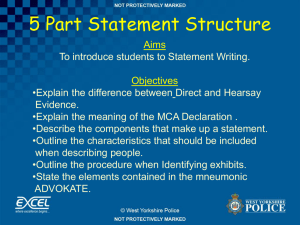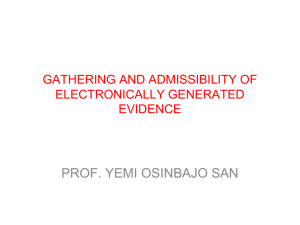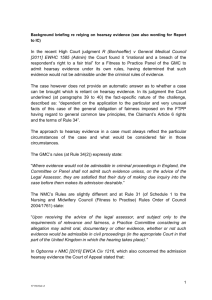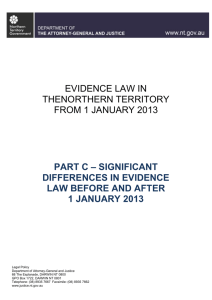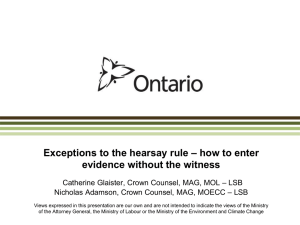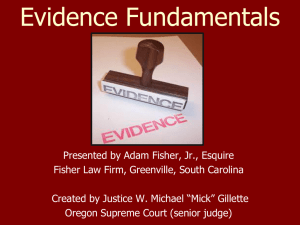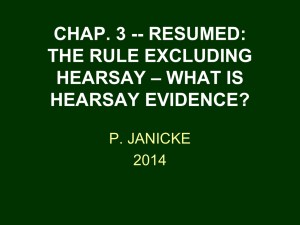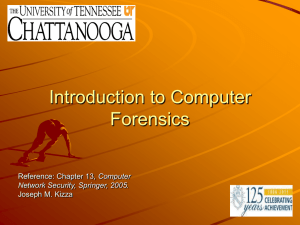Changing Face of the Rule against Hearsay in English Law, The
advertisement
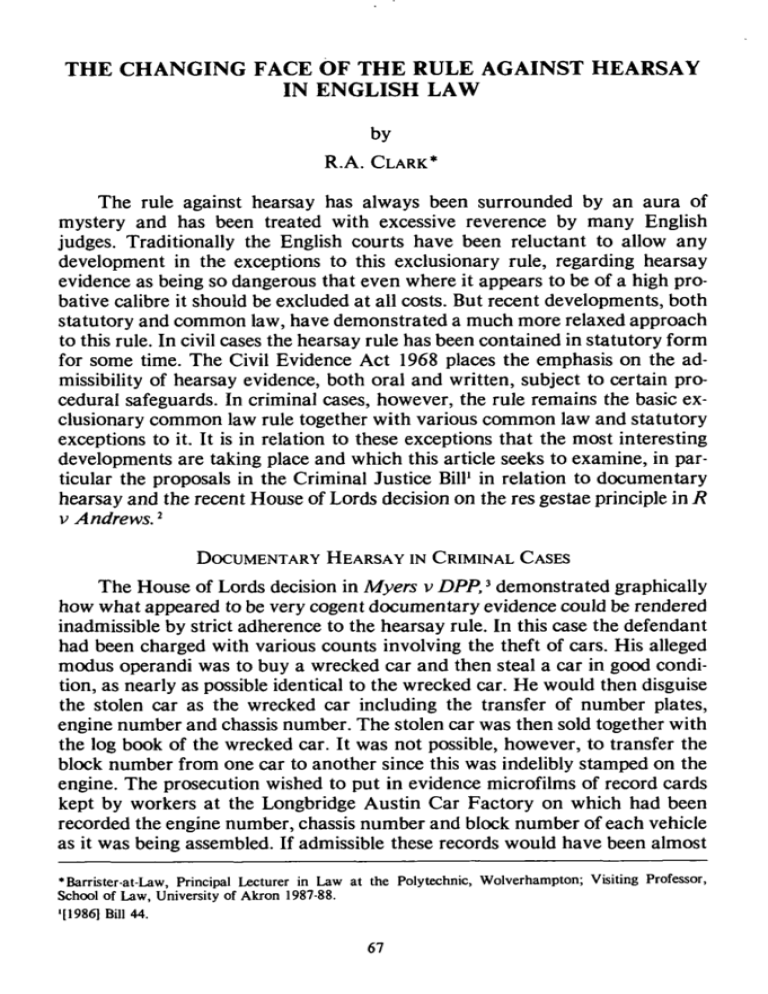
THE CHANGING FACE OF THE RULE AGAINST HEARSAY IN ENGLISH LAW by R.A. CLARK* The rule against hearsay has always been surrounded by an aura of mystery and has been treated with excessive reverence by many English judges. Traditionally the English courts have been reluctant to allow any development in the exceptions to this exclusionary rule, regarding hearsay evidence as being so dangerous that even where it appears to be of a high probative calibre it should be excluded at all costs. But recent developments, both statutory and common law, have demonstrated a much more relaxed approach to this rule. In civil cases the hearsay rule has been contained in statutory form for some time. The Civil Evidence Act 1968 places the emphasis on the admissibility of hearsay evidence, both oral and written, subject to certain procedural safeguards. In criminal cases, however, the rule remains the basic exclusionary common law rule together with various common law and statutory exceptions to it. It is in relation to these exceptions that the most interesting developments are taking place and which this article seeks to examine, in particular the proposals in the Criminal Justice Bill' in relation to documentary hearsay and the recent House of Lords decision on the res gestae principle in R v Andrews.I DOCUMENTARY HEARSAY IN CRIMINAL CASES The House of Lords decision in Myers v DPP, demonstrated graphically how what appeared to be very cogent documentary evidence could be rendered inadmissible by strict adherence to the hearsay rule. In this case the defendant had been charged with various counts involving the theft of cars. His alleged modus operandi was to buy a wrecked car and then steal a car in good condition, as nearly as possible identical to the wrecked car. He would then disguise the stolen car as the wrecked car including the transfer of number plates, engine number and chassis number. The stolen car was then sold together with the log book of the wrecked car. It was not possible, however, to transfer the block number from one car to another since this was indelibly stamped on the engine. The prosecution wished to put in evidence microfilms of record cards kept by workers at the Longbridge Austin Car Factory on which had been recorded the engine number, chassis number and block number of each vehicle as it was being assembled. If admissible these records would have been almost *Barrister-at-Law, Principal Lecturer in Law at the Polytechnic, Wolverhampton; Visiting Professor, School of Law, University of Akron 1987-88. '[19861 Bill 44. AKRON LAW REVIEW [Vol. 21:1 incontrovertable evidence that the log books did not belong to the cars and that the cars were stolen. The House of Lords held that these records were inadmissible because they had not been brought to court by a witness who had been responsible for compiling the records and who could testify as to the accuracy of the records. The Court of Appeal in Myers" had held that the records were admissible on the simple grounds that the evidence did not infringe the hearsay rule because its probative value did not depend upon the credit of an unidentified person, but rather on the circumstances in which the records were maintained and the inherent probability that it was correct rather than incorrect. In other words, they placed the emphasis on probative value as the basis for the admissibility of what might otherwise be considered hearsay evidence, rather than technical exceptions to an exclusionary rule. This was to be the approach adopted in relation to similar fact evidence by the House of Lords in DPPv Boardman.5 But the House of Lords rejected this approach, preferring to uphold the established view of the hearsay rule. As Lord Reid said in his judgment: "This is a technical point, but the law regarding hearsay evidence is technical, and I would say absurdly technical." 6 Nevertheless it was technicality that decided the case and rendered the Longbridge records inadmissible. The consequence of the Myers case was that it was left to Parliament to extend the exceptions to the hearsay rule in criminal cases by making admissible certain types of documentary hearsay. S.L.i. of the Criminal Evidence Act 19657 therefore provided for the admissibility of business records where direct oral testimony of the contents of those records would have been admissible and where the person who supplied the information contained in the record was dead, beyond the seas, unfit, could not with reasonable diligence be traced, or could not reasonably be expected to have any recollection of the matters dealt with in the information he supplied. This new statutory exception to the hearsay rule could be seen as an extension of the long established common law rule which admits the declarations of deceased persons acting under a duty to do an act and record it in the ordinary course of business. The principal flaw in the 1965 act was that it was restricted to business records. This was highlighted in a number of post 1965 cases, a good example of which was R v Patel.8 In Patel,the defendant was charged, inter alia, with assisting illegal entry 2119871 1 All E.R. 513. '[19651 A.C. 1001. '[19651 48 Crim. App. 348. '[19751 A.C. 421. 61[19751 A.C. at 1007. 711965] C. 20. 8[19811 3 All E.R. 94. Summer, 19871 ENGLISH RULE AGAINST HEARSAY into the United Kingdom contrary to s.25.i.d. of the Immigration Act 1971.1 The disputed evidence consisted of Home Office records which revealed that the alleged illegal immigrant was not a person entitled to a certificate of registration in the UK. These records had been brought to court by an immigration officer to prove that the person Patel had helped to enter the country was an illegal immigrant. The records had not been compiled by the immigration officer and so he was not able to testify as to the method of compilation and custody of the records; thus the records were left to speak for themselves and were consequently inadmissible hearsay. Furthermore, these records were not of a kind covered by the exception in s.l.i. of the Criminal Evidence Act 196510 since they were not business records. The principle in Myers was therefore followed: that the rule against hearsay is a strict exclusionary rule. Only when such evidence falls within a clearly established exception to the rule can it be admitted. As a matter of logic there can be no reason why business records should be admitted in criminal proceedings when records kept by public bodies are not. For this reason s. 68 of the Police and Criminal Evidence Act 198411 repealed the 1965 act and replaced it with a much broader statutory exception. This section provides for the admissibility of any documentary record where the person compiling the record was acting under a duty from information supplied by a person with personal knowledge of the matters dealt with, subject to the condition that the supplier of information is dead, unfit, beyond the seas, it is not reasonably practicable to secure his attendance at court, or he cannot reasonably be expected to have any recollection of the matters dealt with in that information. This exception is therefore wide enough to cover the facts in both Myers and Patel so that both lots of records would now be admissible. THE CRIMINAL JUSTICE BILL 1' It seems that the life of s.68 of the Police and Criminal Evidence Act 3 is going to be a short one. Clause 14 and clause 15 of the Criminal Justice Bill, currently on its way through Parliament provide for a much wider statutory exception to the hearsay rule in respect of documents. Clause 14 provides as follows: A statement made by a person in a document shall be admissible in criminal proceedings as evidence of any fact of which direct oral evidence by him would be admissible. 4 The effect of this provision will be to make admissible all first hand 911971) C. 77. 0 119651 C. 20. "[19841 C. 60. 1211986] Bill 44 [the enactment of this bill has been delayed by the 1987 general election]. 13119841 C. 60. 1[1986] Bill 44. AKRON LAW REVIEW [Vol. 21:1 documentary evidence whatever its nature, subject to a discretion to exclude contained in clause 16. This is, therefore, a very far reaching provision going well beyond any previous statutory exceptions. The emphasis is placed on admissibility rather than inadmissibility, and there are no restrictions on the types of documents covered: they need not be business records or documents compiled by someone acting under a duty and there are no pre-conditions that the declarant be dead, unavailable, unfit, beyond the seas or unable to remember the facts recorded in the document. Clause 15 deals with 'business' documents, rendering admissible statements in documents compiled in the course of any trade, business, profession or other occupation, or by a person as the holder of any paid or unpaid office." This provision will be wide enough to cover situations like Myers and Patel, but also documents from a wide range of other sources, including documents kept by officers of purely private organizations, such as clubs and societies, etc. The clause is not restricted to records nor is there any precondition that the recorder be acting under a duty, although the supplier of the information contained in the document must have had or be reasonably expected to have had personal knowledge of those facts. There are no preconditions concerning the availability of the declarant. Many documents will be admissible by virtue of both clauses but documents admissible under clause 15 include those containing multiple hearsay, whereas clause 14 only applies to first hand hearsay. Both clause 14 and clause 15 are made subject to a judicial discretion to exclude contained in clause 16 of the bill. This discretion is broadly expressed and must be exercised "in the interests of justice." Factors which the judge or magistrate may take into account in exercising this discretion include the nature and source of the document, the likelihood that it is authentic, whether or not the evidence contained in the document is available by other means, the relevance of the evidence and the possibility of controverting the statement. These factors specified in clause 16.ii. are without prejudice to the generality of the discretion. Clause 17 provides that statements in documents made for the purposes of pending or contemplated litigation or criminal investigation may only be admitted with the leave of the court. This is presumably intended to prevent the prosecution from basing the whole of their case on police statements without having to call the makers of those statements as witnesses. However, if the bill passes into law in its current form it will be theoretically possible, though highly unlikely, for this to happen. The total effect of this bill is to place the emphasis on admissibility of documents in criminal cases. It will be interesting to see how the judiciary ap- ENGLISH RULE AGAINST HEARSAY Summer, 19871 proach the use of the discretion. If they take a liberal approach it may well be that documentary evidence will sometimes constitute the bulk of prosecution evidence and oral testimony will become the exception rather than the rule. This would have major consequences for the defense and the art of the defense lawyer. In view of the fact that in most criminal cases the object of the defense lawyer is to discredit the prosecution case by skillful cross examination of prosecution witnesses, very different skills will be required if there are no witnesses to cross examine. If, on the other hand, the judges are restrictive in the exercise of this discretion, as they have tended to be in their approach to hearsay evidence, then the introduction of this new approach to documentary hearsay evidence may not turn out to be particularly radical in effect. THE HOUSE OF LORDS DECISION IN R VANDREWS& This important decision on the res gestae principle seems to show a more liberal approach by the courts to the admissibility of hearsay evidence and might therefore be indicative of the way the discretion in the Criminal Justice Bill will be applied. In Andrews, a man was attacked in his flat when he answered the door to two men. He was discovered by a neighbor who summoned the police. When the police arrived a short time later, the victim was able to identify one of his attackers. He died two months later. His statement was not a dying declaration and could only be admitted if it formed part of the res gestae. The defense argued that the statement was not sufficiently contemporaneous with the attack to form part of the res gestae, relying heavily on the case of R v Bedingfield. 17 The House of Lords however chose to restate the principles laid down by Lord Wiberforce in the Privy Council decision in Ratten v The Queen, 11 in which he placed the emphasis on the possibility of concoction or distortion as the basis for the admissibility/inadmissibility of res gestae statements. The question of contemporaniety should be determined on the basis of whether the facts of the case were the dominant factor in the declarant's mind at the time the statement was made. In other words, the emphasis is on the strength of the evidence rather than strict adherence to technical rules. This can be seen as a very different approach from that of Lord Reid in Myers v DPP,9 referred to at the beginning of this article. It has been suggested by some writers 0 that the approach in Ratten should be adopted as the test for admissibility of hearsay evidence generally, so that strong, probative hearsay evidence, both oral and written, would be admissible [the possibility of concoction or distortion being the test] whereas weak hearsay of little probative value would be excluded. It will be interesting to see, therefore, 16[19871 1 All E.R. 513. 1[71879114 Cox C.C. 341. "119711 3 All E.R. 81. "See ante p. 1. "E.g. CARTER: CASES& MATERIALS ON EVIDENCE, 405 (1981). AKRON LAW REVIEW [Vol. 21:1 if this broad approach is adopted in relation to the discretion to exclude documentary hearsay in the new bill. SUMMARY There is no doubt that the last twenty years has seen a gradual erosion of the rule against hearsay in English criminal law. This has been as a result of statutory intervention, the courts having adhered to a predominantly restrictive and technical approach to the hearsay rule. The combined effect of a new Criminal Justice Act including radical provisions on documentary hearsay and a broader less technical approach to oral hearsay by the courts as suggested in Andrews may well herald the end of the hearsay rule as we know it, bringing English law into line with most other systems, where the nature and source of an item of evidence is significant only as regards weight and does not affect its admissibility. This would also mirror the approach English law takes to that other major exclusionary rule of evidence, the similar fact evidence rule in Boardman. If, however, the common law had adopted the approach of the Court of Appeal in Myers, it might well have been the case that this piecemeal statutory reform would not have been necessary and the courts would have been able to control their own destiny on the admissibility of hearsay evidence.
